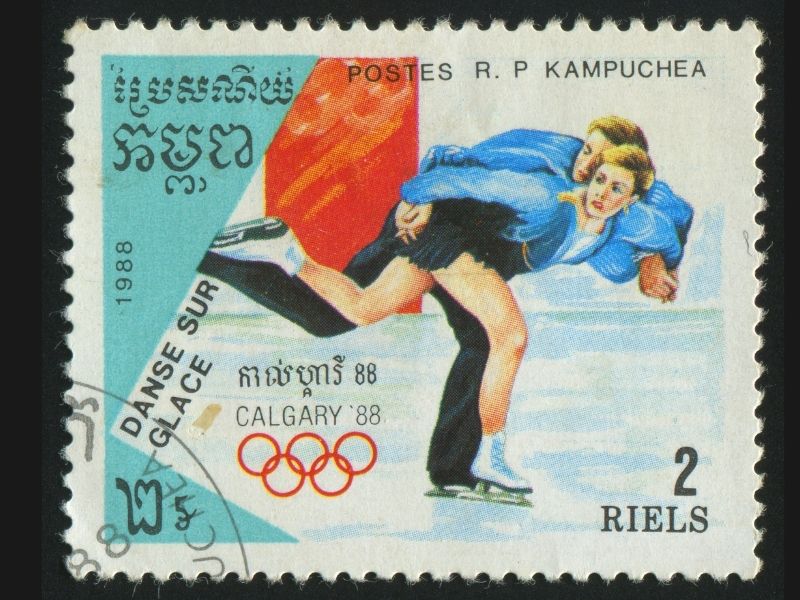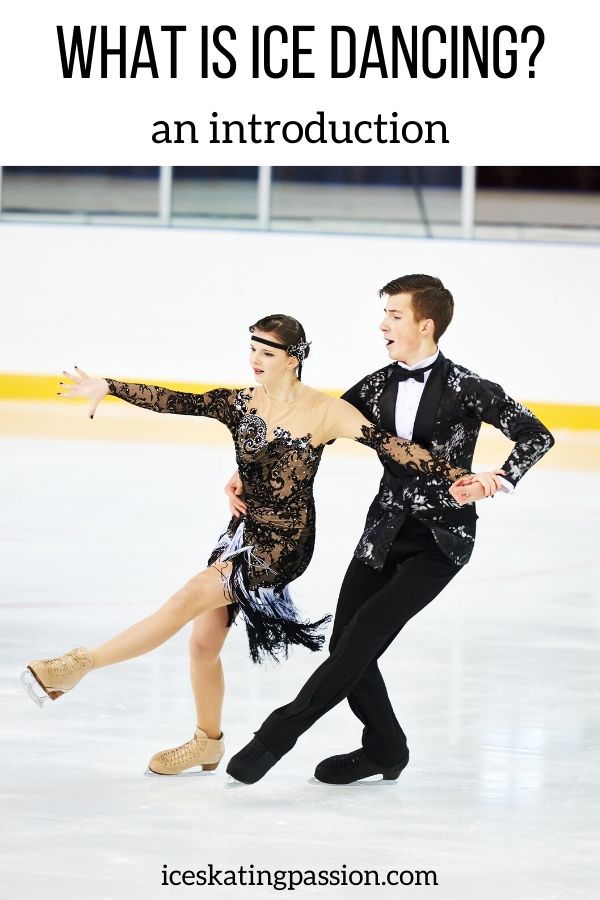What is ice dance? Sometimes figure skating events can become confusing. The article below will give you a brief introduction to ice dancing for you to understand better: how it is a different discipline, its history, rules and scoring...

This article contains affiliate links. If you purchase using my link, I get a commission at no extra cost to you (learn more).
What is ice dance - Introduction
Ballroom dancing on ice
Ice dance is sometimes called Ice Dancing.
It is one of the disciplines of figure skating.
- At its origin, it is simply a transposition of ballroom dancing on the ice.
- Contrary to the other figure skating disciplines, ice dancers focus on the technical footwork on the ice and on the dancing aspect interpreting the musing.
- At national level it can be skates alone or as a pair. At international level, competitions are only for pairs.
- Contrary to pair figure skaters, there are hardly any jumps and lifts have different rules
You can learn more on the differences between figure skating and ice dance in this article.
Meryl Davis and Charlie White, Luu, CC0
Events
Ice dance has 2 main events at international competitions
- The Rhythm Dance -
The rhythms and themes of the dance are determined by the ISU prior to the start of each new season (for example: Folk for 2020/2021). They also identify pattern dance move that has to be incorporated into the dance so as to compare technical skills between dancers. - The Free Dance –
According to the "2019 U.S. Figure Skating Rulebook" defines it as "the skating by the couple of a creative dance program blending dance steps and movements expressing the character/rhythm(s) of the dance music chosen by the couple".
At lower levels there are also compulsory dances, where the skaters perform the exact same routine several times in a row to compare technical skills.

Papadakis / Cizeron - Bff, CC BY-SA 4.0
History of ice dancing
Origins
Ice dancing or figure skating originated in the mid-1800s. Back then, skaters treated the flat ice as an open-air ballroom. Conservative moves, with both feet firmly planted on the floor, were the norm.
Social pair skating was popular during the 1800s, where Ice skaters borrowed from marches, waltzes, and other social dances.
Jackson Haines, an American ballet dancer, took figure skating to another level. His style of ice skating was not appreciated in the USA. He moved to Europe and trained the Viennese to dance on the ice individually or in pairs. European and American waltzes proved to be favorites.
Changes occurred over the years. Simple steps became more complicated. Delicate ballet steps also made an appearance. The genres of music also grew diverse at this time, and all this helped in bringing greater diversity into ice dancing.

Competition
Ice dance began with the elite classes. Later on, all classes joined in. In turn, this led to it becoming a competitive sport.
Russia hosted the first event in 1896. Only males were participating`. In 1906, organizers hosted a similar competition for women in Switzerland.
Ice dancing remained the hottest global trend during the early 1900s. People still viewed this discipline as a leisure-time activity. However, local clubs in the U.S. and the UK organized informal contests, during the 1920s. Right up to the 1930s, three forms of ice dance predominated with dances like the Ten step, the fouteen-step and the Killian.
By the mid-1930s, people began to think of professional competitions. The ISU decided to formulate specific standards, rules and tests for global events.
This led to the initiation of international competitions in the 1950s. The first World Championships event was in 1952. The European Championships was in 1954.

Tessa Virtue and Scott Moir - 2017 World - David W. Carmichael, CC BY 3.0
Olympics
While figure skating appeared at the Summer Olympics in 1908, ice dance remained a leisure sport.
Prior to 1976, the Olympics Committee permitted ice-dancing displays as exhibition performances.
However, the Winter Olympics in 1976, at Innsbruck, changed all that. Ice dance became an official Olympic sport. Austria was the host. The Soviet Union’s pair of Aleksandr Gorshkov and Lyudmila Pakhomoa won the gold medal.
The 2010 Winter Olympics brought more changes. The compulsory dances disappeared.
Ice dance performers began performing only 2 events. They combined rhythm (original dance form) and free dance forms. Combined spins were introduced. This led to routines being more exciting watch for TV.
Basic rules
The rink
Ice dance is performed on an Olympic-sized figure skating rink.The dimensions are 60 metres (196 feet 10 inches) by 30 metres (98 feet 5 inches).
The elements
The rules of Ice dance require the pairs perform specific elements to create a well-balanced skating program.
They include:
- Dance lift: "a movement in which one of the partners is elevated with active and/or passive assistance of the other partner to any permitted height, sustained there and set down on the ice". Difficulty is increased by rotating or adding changes in position during the lift. Dance lifts are often dramatic and exciting.
- Dance spin: "a spin skated by the Couple together in any hold". It can be a single position spin or combine different positions (with a smooth changing)
- Step sequence: "a series of prescribed or un-prescribed steps, turns and movements".
- Twizzle: "a traveling turn on one foot with one or more rotations which is quickly rotated with a continuous (uninterrupted) action".
- Choreographic elements: "a listed or unlisted movement or series of movement(s) as specified"
Skaters must execute the prescribed elements at least once.
Meryl Davis and Charlie White, Luu, CC0
Scoring (at international level)
The scoring method has evolved significantly in the last 10 years. It is now very technical and difficult to explain.
Nowadays, each performance—a Technical score and a Program components score.
Technical score
The technical score is based on the difficulty and execution of the technical elements listed above
- Each element of the program is assigned a base value, which gives skaters credit for every element they perform.
Some elements, such as spins and step sequences, have levels of difficulty on which the base values are established - Judges grade the quality of each element using a grade of execution (GOE) score within a range of -5 to +5, which is added to or deducted from the base value. GOEs are proportional to the base value of each element
- The highest and lowest scores for each element are thrown out, and the remaining scores are averaged to determine the final GOE for each element. The GOE is then added to or subtracted from the base value for each element, and the sum of the scores for all elements forms the technical score.

Grand Prix final 2019, Luu, CC BY-SA 4.0
Program components Score
This score is based on the artistry, the interpretation of the music and the dancing display.
The judges give points from 0.25 to 10 (in increments of 0.25) for five components of the program:
- Skating Skills -
It considers the overall quality of the skating quality: the edge control, the fluidity, the flow over the ice surface, the effortless speed, the cleanliness of the foot techniques. - Transitions -
The difficulty and variety of transition in footwork, positions and pair hold. - Performance -
How the skater gets involved in the choreography, the harmony, the style and personnality - Composition / choreography -
How the movements of the routine are arranged to create a fluid choreography that is proportionate, uses the spaces, creates pattern, is structured around the music... - Interpretation of Music -
"the personal and creative translation of music to movement on ice" - e.g. expression of the music style, interpretation of nuances in the music
As with Grade of Execution, the highest and lowest scores for each component are thrown out, and the remaining scores are averaged. The final program components scores are then multiplied by a set factor to ensure the technical score and program components score are balanced.
Deductions
Deductions are applied in case of:
- Fall
- Illegal element
- Interruption in performance
- Non respect of timing
- And many many other rules (such as length of lift, music, tempo costumes…)
The scores are then added.

Equipment
Skates
Like for figure skating the overall skate is a boot and a blade with toepicks.
However when starting competition, differences appear in the skates :
- the blade for ice dance is shorter at the end. It is not much longer than the boot as opposed to figure skates.
- At high level, ice dancers often have special boots that are cut at the back to allow for better lines when pointing toes.
However, the rest of the equipment remain the same (skate guards, soakers, bags...)

Costumes
Finally, as a general rule, ice dancing dresses are often longer than figure skating.
Here again it is logical since figure skaters need aerodynamic outfits to jump and spin. If the dress is too long, it will limit their movements.
If you are looking for a gift for an ice dancer, most items in my figure skating gift guide are perfect.
Famous ice dancers
At international level, ice dance can only be performed as a couple.
Europe long dominated the discipline. But Canadians And Americans have been winning more frequently since 2010.
Famous Ice dancing couples include:
- Jayne Torvill and Christopher Dean (United Kingdom) - Olympic gold in 1984 and World champions.
- Oksana Grishuk and Evgeni Platov (Russia) - 4 times World champions (1994 to 1997) - Olympic Gold in 1994 and 1998.
- Marina Anissina and Gwendal Peizerat (France) - 2002 Olympic Champions and 2000 World champions.
- Tatiana Navka and Roman Kostomarov (Russia) - 2006 Olympic gold and 2 times World champions.
- Tessa Virtue and Scott Moir (Canada) - 2010 Olympic Champions, 3 times World champions.
- Meryl Davis and Charlie White (USA) - 2014 Olympic Gold, 2 times World champions.
- Gabriella Papadakis and Guillaume Cizeron - Many times world Champions, Silver Olympic medallists in 2018.
You might also be interested in:













